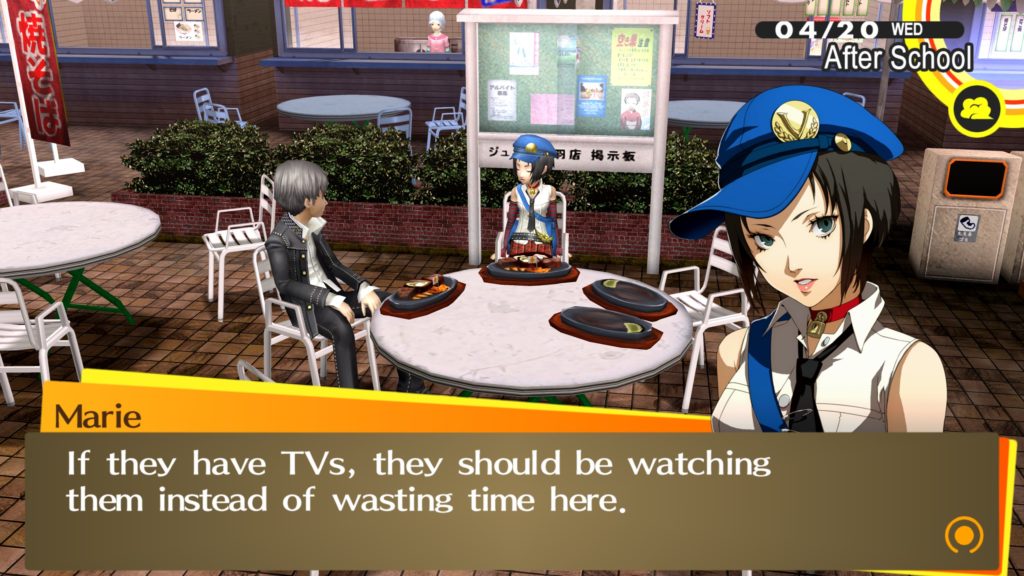In a more consistent world, I’d have played Persona 4 before I played Persona 5. Not because the plots or characters of the two games are at all connected; they are not. It’s because I am continually seeing the P4 characters and plot through a P5 lens. And, I think this is maybe spoiling some plot twists for me, twists that P5 players were supposed to have been expecting.
All Persona games share a similar theme. A series of supernatural events ensnares a high school student, who finds he can travel to a parallel world where people’s subconscious desires — their Shadows — are causing havoc in the real world. He finds he can summon a manifestation of his own inner self — a Persona — to battle these Shadows and free people caught in this parallel world. Other high school students join him and discover their own Personas.
The hero can evoke new Personas by defeating shadows and merging them with the help of a mysterious man known as Igor, who is aided by mysterious companions. As they work through the Shadow world, they learn of a larger plot that could endanger the entire world.

The Persona games are lighter, more casual spinoffs of a grimmer, darker series, the Shin Megami Tensei series, though they share a lot of elements.
I’ve played the original Persona game on the Playstation a really long time ago. I still have the disk, and started it again a few months ago, but it just doesn’t hold up in the present day.
Persona 4 Golden, the version I am playing, is a remaster of the original PS2 Persona 4 game for the PS Vita and remastered again for Steam. The graphics are high resolution and I’d never have known it was a PS2 original. It comes on sale now and again, and I bought it on one of those sales. After watching my boyfriend play through Persona 3 and watching the first episode of the Persona 4 anime, I was ready to have more Persona in my life.

The protagonist, whom I named after one of my cats, is a student sent to live with his uncle, a police detective, in the rural town of Inaba. The Inaba downtown is struggling because a Walmart-like omnistore, Junes (Joo-ness), has set up shop on the outskirts and is slowly sucking up all the commerce.
A sex scandal involving an actress and a newscaster strikes the area when the actress is found to be hiding out in a country inn in the town — and is soon found dead. Soon after, a high school student is also found dead, both of them found suspended by their foot from a high place, suggesting the Hanged Man tarot.
Locals sometimes watch the “Midnight Channel” on TV. Legend has it that if you turn your TV to a dead channel at midnight when it is raining outside, you can dimly see a shadowy shape in the static, moving around. When the Protagonist tries it, he accidentally pushes his hand right into the TV.
He and his friend Yosuke (yo-skay), whose family owns Junes, use the bigger display TVs in the store to enter and explore the TV universe on the other side. There they meet this game’s mascot, Teddie, a hollow, top-shaped creature who claims to be a bear and fills them in on the rules of this shadow universe.

Persona 4 follows the same general arc after that; the Protagonist goes to school, joins clubs, gets a part time job, and in other ways forms bonds with his friends and the other people in town. The “real life” portion of the Persona games is as important as the dungeon crawling and Shadow battling.
Once a new image appears on the Midnight Channel, the Protagonist and his friends must enter the TV world, and with the help of Teddie, free the person trapped there and force them to physically confront the dark side everyone struggles to hide.
I’ve only just started the game — freeing Yukiko was the last thing I did in game. Not a spoiler; she is shown as a member of the team in the opening credits. I can’t talk to how the game shapes up against Persona 3 (which was creepy) or Persona 5 (which was just good clean fun). I do have my suspicions about some plot twists, but we’ll see how they play out.
The game has a really surprisingly robust difficulty setting. Not only can you set the combat difficulty from “Very Easy” to “Difficult”, you can tune the difficulty within them to, for example, keep combat challenging but gain extra experience or money. I’ve done exactly this so that the battles are still fun, but so I won’t have to do so much grinding. I have not seen this granular a game difficulty setting in any other game.
I’m having fun with the game that will probably be the last RPG I finish this year. I probably should have waited until I finished before I wrote my RPGs of 2020 post, but here we are. I wasn’t sure I was going to start this game now, and then I did.




